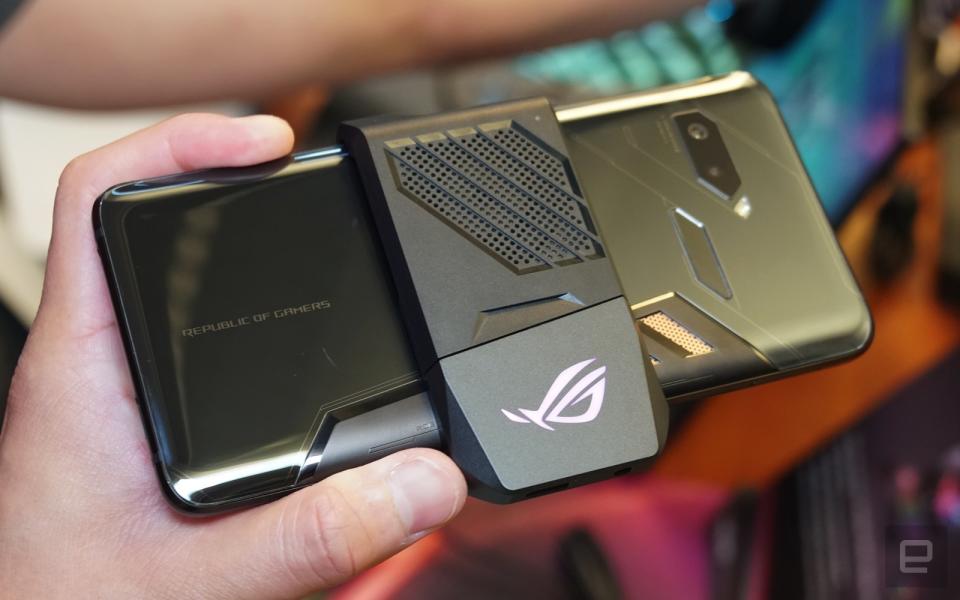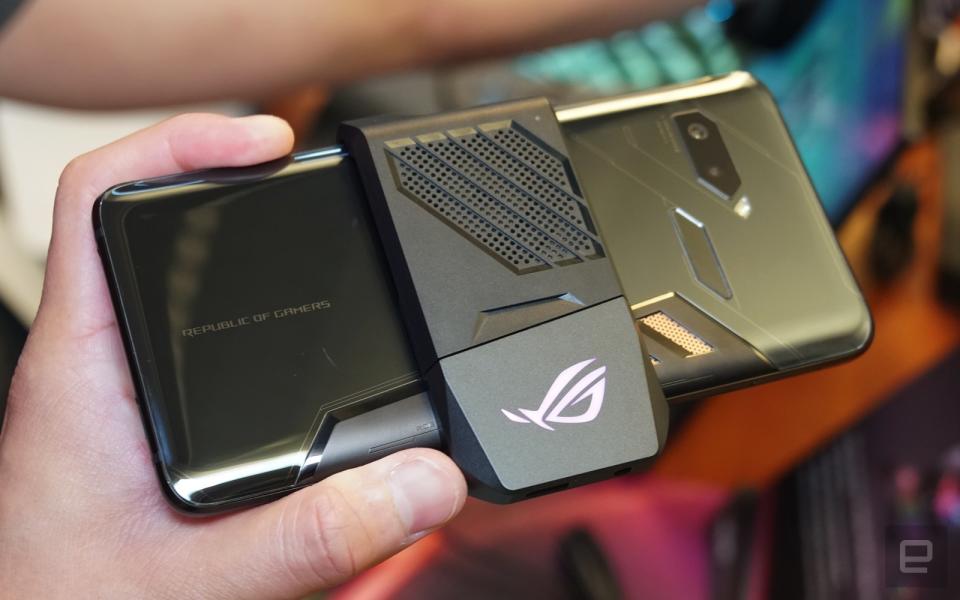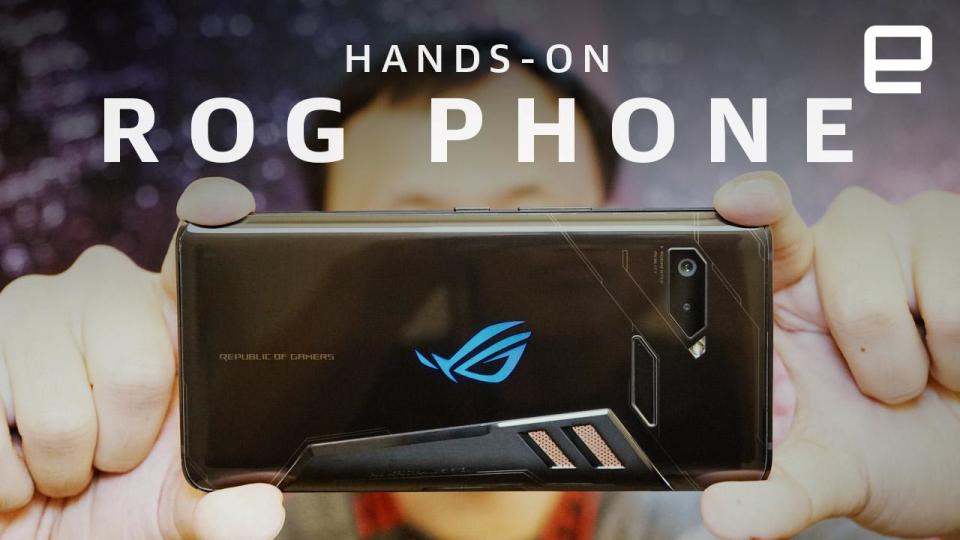ASUS ROG's ridiculously high-spec gaming phone was made for 'PUBG'
The ultrasonic trigger buttons and a clip-on cooling fan are just two of the many gamer-baiting features here.
Thanks to the likes of Free Fire, PUBG and Fortnite arriving on mobile, gaming smartphones seem like a no-brainer for brands that want to break into the crowded smartphone world, with the Razer Phone setting the bar for others to follow. ASUS thinks it can do better. Here at Computex, the company surprised many by unveiling the ROG Phone, its first-ever handset made specifically with gaming in mind.
Needless to say, this aggressive-looking device is specced out as a powerhouse, but it's also packed with many unique and thoughtful features that aim to deliver a better gaming experience. There are also a handful of dedicated accessories -- including an external cooling fan that clips onto the back, plus an optional handheld dock that adds a second screen to the ROG Phone.
As with most other 2018 flagship smartphones, the ROG Phone is powered by Qualcomm's flagship octa-core Snapdragon 845 chipset, but in this case, it's been given a little boost in its top CPU clock speed -- going from the standard 2.8GHz up to 2.96GHz, which is a first in mobile. Another unique feature here is the 6-inch 2,160 x 1,080 AMOLED screen, which supports HDR content (no word on which standards yet) and runs at 90Hz with a 1ms response rate. Even though this isn't quite as fast as the Razer Phone's 120Hz LCD, it's still apparently the fastest AMOLED display on a smartphone, not to mention its advantages over LCD in terms of color gamut and contrast ratio. But if you prefer, you can use the phone's built-in 802.11ad WiGig connectivity to mirror your gameplay to a nearby TV via ASUS' WiGig Dock, so long as your handset has a direct line of sight to the receiver.
There's no word on storage space yet, but ASUS did share that the device will come with a whopping 8GB of RAM, which is the least you'd expect from a serious gaming smartphone. You'll also find a pair of front-facing speakers, the same cameras as the ZenFone 5 (8MP front, 12MP/8MP ultra-wide on the back) and a rear fingerprint reader. As a bonus, there's a silver ROG logo on the back that actually features a programmable RGB backlight: Using the dedicated app, you can choose a static color, have it pulsating, strobing, cycling through various colors or switched off entirely. Better yet, you can synchronize this RGB setting with other ASUS Aura Sync products; you can even synchronize up to five ROG Phones, which would look pretty cool in an eSports tournament.

The most surprising feature might be that the phone comes with not one, but three USB-C ports. In portrait, there's the usual one at the bottom, and then two conjoined ports on the left. The idea here is that you'd be able to keep the phone plugged into a power source, but without the cable getting in the way of either of your hands. As to why these ports are conjoined, well, they are actually designed for a handful of specially-made accessories -- more on those later.
Another unusual feature on the ROG Phone is the presence of three ultrasonic sensors. Two of these serve as programmable shoulder triggers for landscape gaming, which lets you see more of the screen since your index fingers are now out of the way. These triggers worked surprisingly well during my brief Asphalt 9 gameplay.
When holding the phone in portrait, you'll find the third sensor at the bottom of the left side, and together with its counterpart on the right, it lets you squeeze the phone to quickly toggle apps -- very much like the feature on recent HTC flagships, except those phones use strain gauges instead of ultrasonic sensors found on ROG's device.
All of that extra processing power on the ROG Phone is backed by its generous 4,000mAh battery -- this is supported by ASUS HyperCharge, a power management design which places the hot charging chip in the power adapter instead of the phone. More importantly, there's a "3D vapor-chamber cooling system" -- essentially a massive slab of copper heat radiator plus some carbon cooling pads attached to the circuit board -- that covers most parts of the phone internally. This apparently provides 16 times more heat dissipation area than a standard smartphone cooling design, thus allowing a longer CPU peak endurance by up to five folds.
But that's (still!) not all, as ASUS is also throwing in an "AeroActive Cooler" that clips onto the phone's curved glass back. This plugs into the conjoined USB-C ports to power its fan and RGB logo, and both can be configured in the companion app mentioned earlier. Personally, I found that the attachment could sometimes get in the way of my hands. Maybe I could get used to it over time? I'm not sure. On the positive side, this attachment also has a 3.5mm headphone jack, meaning you have a second option to suit your phone's orientation needs.
The AeroActive Cooler is just one of the many bizarre accessories made for the ROG Phone. The most intriguing of all is the optional TwinView Dock that, as you can tell by the name, is a handheld grip that comes with a second screen plus extra battery juice (capacity to be confirmed). You simply attach the phone to the top via the conjoined USB ports, and then you'll be able to play your game in your choice of screen, leaving the other for watching reactions from viewers of your hypothetical gameplay stream. ASUS is also hoping to get developers to come up with games that make use of both screens, which would effectively turn the ROG Phone into a Android-powered Nintendo DS-a-like. With the lack of connectivity and content, I wasn't able to fully appreciate this dual-screen option, but I do wish that the final product will be lighter. And if you prefer the good ol' physical buttons for gaming, like most of us, ASUS has teamed up with Gamevice to create a clamp-on controller pad for the ROG Phone.
Last but not least, there's the Mobile Desktop Dock, which is rather self-explanatory, but what makes it stand out from Samsung's similar dock is that it can be plugged into a PC, and with a simple click of a button, you can use the same monitor, mouse and keyboard to access either the PC or the ROG Phone. A bit like a KVM switch, if you like, which makes this setup a lot more versatile.
ASUS' ROG Phone is certainly shaping up to be the most ambitious gaming phone since Nokia's N-Gage. In fact, it's safe to say that this even puts the recent Razer Phone to shame with all these extra features. But is there really a market for this kind of product? We shall see when there's a price and launch date later this year -- some time in Q3.
Click here to catch up on all the latest news from Computex 2018!


































